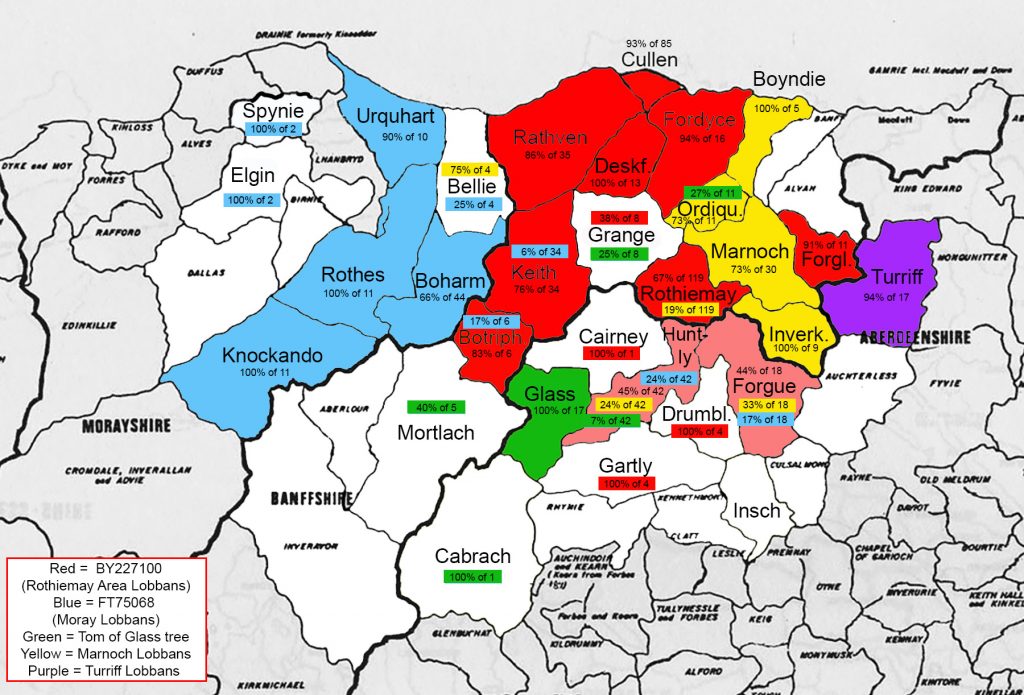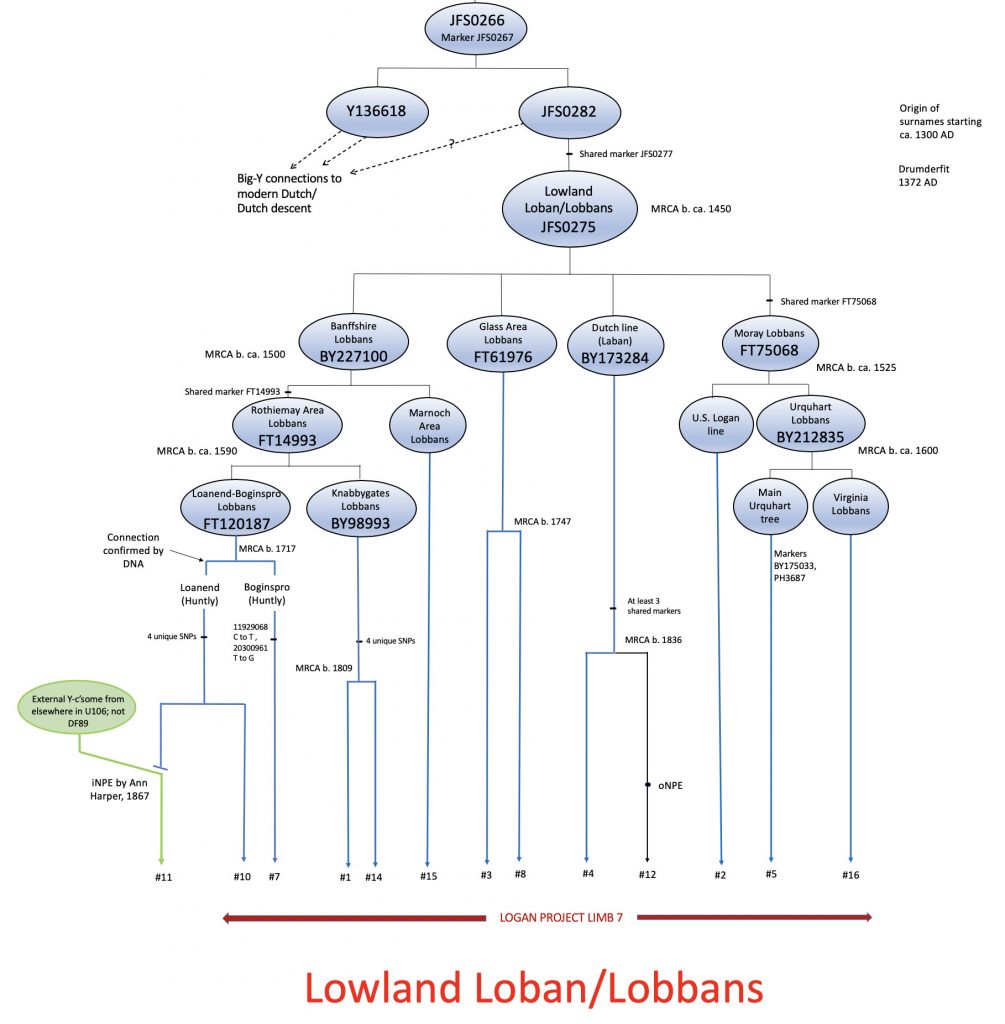Development of structure within NE Scotland Lobbans tree
At the end of the first phase of the project, as described in the Status Report, Sep. 2019, we had established that there were 4 lines of descent within the NE Scotland Lobbans, that the Inverness Lobbans on the basis of a single sample were unrelated to the NE Scotland Lobbans, and hypothesized that the NE Scotland Lobbans might have a Flemish origin. During the last six months we have tried to link all the remaining family trees into this framework and to analyze and map the family trees for each group in the NE Scotland Lobbans. That is now largely complete, and the remaining work to be done is to try to find more descendants of Inverness/Black Isle families to develop that side of the family (there appear to be few branches that have continued to the present day), and to find the connection of the Turriff Lobbans (descendants in Michigan) to the NE Scotland Lobbans tree. Please refer to the geographic distribution map below.

With the addition of four more Y-700 samples solicited to improve understanding of the four main lines, we now have the following picture of the NE Scotland Lobbans (the rest of the tree has not changed from what it was at the last Y-DNA update).

The most recent common ancestor (MRCA) remains JFS0275, who based on Y-DNA results was born about 1450. Whether this was the hypothetical Flemish founder is still unknown; he might have been a few generations earlier. There are four branches arising from this common ancestor, over the next 50–100 years, or 2–3 generations. On average there is one new SNP every 3 generations, so that these four branches must have arisen in different lines — a son here, a grandson from a different son, and so on. The four lines are now called Banffshire Lobbans (BY227100), Glass Area Lobbans (FT61976), Dutch Laban line (BY173284), and Moray Lobbans (FT75068). It is difficult to speculate on the relative ages of these branches, but the facts that the Banffshire Lobbans were most widespread and numerous, and that their MRCA has now been pushed back to about 1500, suggests that this may have been the first. However, the geographic distribution is skewed because the other three haplogroups all had early emigration events so that large parts of the descendant population do not appear on the map (in the case of the Dutch Laban line, the entire tree is in Holland).
Structure within the Banffshire Lobbans (BY227100)
We originally thought that BY227100 represented the Rothiemay Area Lobbans, but the recent finding that the Marnoch Area Lobbans are ancestral to them has led to renaming BY227100 as Banffshire Lobbans and defining the Rothiemay Area Lobbans by the new haplogroup FT14993. The Marnoch Lobban tester lacks the FT14993 marker that the four Rothiemay area Lobban testers have. The Marnoch Lobban group needs another tester before its haplogroup marker can be determined.
Within the Rothiemay Area Lobbans we have identified nine groups by mapping the family trees that are supported by written records — this accounts for 8 groups — and from Y-DNA evidence that linked the Loanend Kinnoir–Boginspro branch (FT120187) with the Knabbygates branch (BY98993), now each with two testers (details here and here).
Structure within the Moray Lobbans (FT75068)
With the connection of the Virginia Lobbans, we also now see two levels of structure within the Moray Lobbans. The first branch, probably about 1525, split off the U.S. Logan line from Urquhart Lobbans (BY212835). The Logan line was already in Aberdeen and the name changing from Loban to Logan when they first appear in the records in the early 1600s. One of the grandchildren emigrated to South Carolina and founded an extensive tree. Within the Urquhart Lobbans this split also leads to a major tree in the US, the Virginia Lobbans.
Glass Area Lobbans
The Glass Area Lobbans appear on the map to be a small group, dominant only in Glass Parish, Aberdeenshire, but the family tree includes two major emigrant branches, one group going to Australia and the other (the US Loban line) going to Illinois, with the third branch mostly staying in Scotland. The connections between all these branches are known from written records.
Dutch Laban Line
The origin of this branch from William Lobban is well established, though his ancestry is still a mystery, beyond being established as within JFS0275. He settled in Tholen, Zeeland, Holland, where many of his descendants still live (details).
Non-paternity events
The tree also includes examples of inbound and outbound nonpaternity events (NPEs), i.e., when a boy for any reason does not bear the name of his father. This is not the same as illegitimate child: baptisms records show that illegitimate children were usually given the father’s name, so not NPEs, whereas some legitimate children were later adopted. In the Loanend Kinnoir line Ann Harper pinned paternity of her 1867 son on a Lobban, and his denial of it was recently substantiated by a specific marker test. There were also several inbound NPEs in the Glass Lobbans, including one where a man adopted the name to retain tenancy of a croft. The connection of the outbound NPE in the Laban line to JFS0275 was established early on in testing, and more recent ThruLines(R) results from Ancestry.com have narrowed down the connection to a probable MRCA.
Lobban DNA Project at FTDNA
We have established a Lobban DNA Project at FTDNA, so that, while remain under the umbrella of the Logan DNA Project (as Limb 7) and the Pre1800sLogans social group, we now have our own identity, which will help future testers to find us, and will help me and future genetic genealogists pull up the data. The link is https://www.familytreedna.com/groups/lobban-dna-project/about.
Thanks, as always, to John Sloan, R-U198 Project, for his interpreation of the results.
Page by Christopher S. Lobban, posted 23 Mar. 2020
